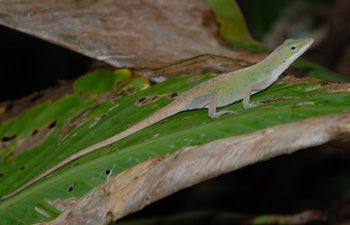SCIENTIFIC NAME:
Anolis carolinensis carolinensis
OTHER NAMES:
'chameleon'
STATUS:
Common and statewide in occurrence, but relatively scarce in extreme northern portion. Lowest Conservation Concern.
DESCRIPTION:
Green anoles (Anolis carolinensis) are generally 5-8 inches long. Females are usually smaller than males and may be less than five inches in length. Their color ranges from bright green to brown and greys. The green anoles color depends on their mood, health, temperature and humidity. They are often referred to as “chameleons” because of their ability to change color; however, they are not related to chameleons. Green anoles have adhesive lamellae on their footpads which helps them climb smooth surfaces. They have long, slender bodies and a pointed snout. Male green anoles have a pink dewlap, a flap of skin that hangs down in an arc below their neck. This dewlap will help the males attract female anoles for mating and is used in territorial displays.
DISTRIBUTION:
The green anole is the only anole native to the U.S. They live in the Southeastern United States from east Texas to southern Virginia. Unfortunately, the majority of green anoles sold in the pet trade are ones removed from the wild in the southeastern United States. There are an estimated 250 species of anoles in the world. Due to the pet trade, 36 species of non-native anoles have been documented breeding in the wilds in Florida. Interbreeding of native anoles with non-native ones has resulted in various marking and color patterns that are considerably different from truly wild anoles.
HABITAT:
Green anoles are commonly found in Alabama around homes, in flower gardens, in low bushes or shrubby areas, on rock walls, in the woods and in trees. They require green plant vegetation, some shade and a moist environment. Although they are primarily terrestrial, they can be found on the ground underneath low shrubs or plants.
FEEDING HABITS:
Green anoles eat small insects, grubs and spiders. They will stalk their prey in shrubs, vines, walls and even on window screens. The prey must move in order for the anole to find it.
LIFE HISTORY AND ECOLOGY:
Green anoles may breed anytime from late March to early October. Signs of breeding include males displaying their dewlaps and posturing to females. If the female runs away she is not ready to mate; if she stays or while running allows herself to be caught, and bows her head, the male will grab her neck with his mouth and they will mate. Females can lay a single egg every two weeks. The eggs are leathery (1/4-3/8 inches in length) and are laid in moist soil. They will hatch in 5-7 weeks. Usually one egg is laid every two weeks for a total of 10 eggs per breeding season.
Male anoles have a set of rituals they perform to establish dominance and territoriality. They will move their head up and down, like a push-up movement, to show their dominance and then flare their dewlap. Often when threatened by another male, they will start by bobbing their head and flaring their dewlap. They will extend their throat, enlarge their body profile, turn to the side of the opponent, showing the side profile of body, erect crest along back, and form an eyespot. The loser of the confrontation will perform submissive head bobbing and retreats to different territory.
REFERENCES:
Kaplan, M. 2003. “Anole.” Anapsid. Accessed July 20, 2006 at http://www.anapsid.org/anole.html.
Smith, R. 1999. "Anolis carolinensis" (On-line), Animal Diversity Web. Accessed July 20, 2006 at http://animaldiversity.org/accounts/Anolis_carolinensis/
Author:
Jeff L. Makemson, Certified Wildlife Biologist, Alabama Division of Wildlife and Freshwater Fisheries






